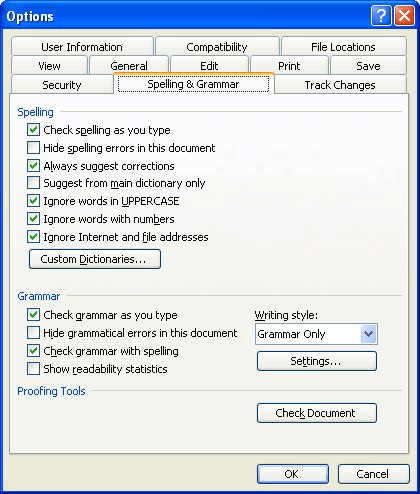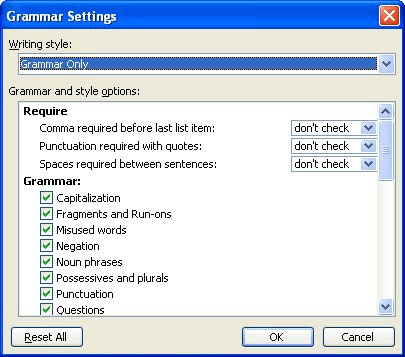Please Note: This article is written for users of the following Microsoft Word versions: 97, 2000, 2002, and 2003. If you are using a later version (Word 2007 or later), this tip may not work for you. For a version of this tip written specifically for later versions of Word, click here: Setting Grammar-Checking Options.
Word includes a full-featured grammar checker that allows you to check your document (or a section of it) for common grammar mistakes. Each potential error is displayed and you are given the opportunity to make changes.
Word has several different writing styles that you can select when using the grammar checker. Each one of these styles is a different collection of grammar rules that will be used when you use the grammar checker. Some sets of rules that are very strict with a lot of rules to check while others are quite lax and better for casual writing. If you find that these styles use rules that are unnecessary, too restrictive, or not quite right for your documents, you can modify them in the following manner:

Figure 1. The Spelling & Grammar tab of the Options dialog box.

Figure 2. The Grammar Settings dialog box.
WordTips is your source for cost-effective Microsoft Word training. (Microsoft Word is the most popular word processing software in the world.) This tip (1031) applies to Microsoft Word 97, 2000, 2002, and 2003. You can find a version of this tip for the ribbon interface of Word (Word 2007 and later) here: Setting Grammar-Checking Options.

Do More in Less Time! An easy-to-understand guide to the more advanced features available in the Microsoft 365 version of Word. Enhance the quality of your documents and boost productivity in any field with this in-depth resource. Complete your Word-related tasks more efficiently as you unlock lesser-known tools and learn to quickly access the features you need. Check out Microsoft 365 Word For Professionals For Dummies today!
Text boxes are a common design element in a document. You may wonder if the text you place in a text box can be spell ...
Discover MoreMost of the time Word will check both grammar and spelling at the same time. You can, however, instruct the program to ...
Discover MoreIf your writing often contains words that include numbers, you'll want to make sure you set up the spelling checker to ...
Discover MoreFREE SERVICE: Get tips like this every week in WordTips, a free productivity newsletter. Enter your address and click "Subscribe."
There are currently no comments for this tip. (Be the first to leave your comment—just use the simple form above!)
Got a version of Word that uses the menu interface (Word 97, Word 2000, Word 2002, or Word 2003)? This site is for you! If you use a later version of Word, visit our WordTips site focusing on the ribbon interface.
Visit the WordTips channel on YouTube
FREE SERVICE: Get tips like this every week in WordTips, a free productivity newsletter. Enter your address and click "Subscribe."
Copyright © 2026 Sharon Parq Associates, Inc.
Comments